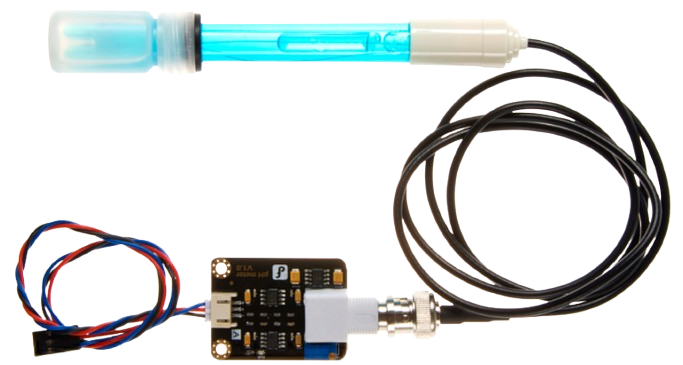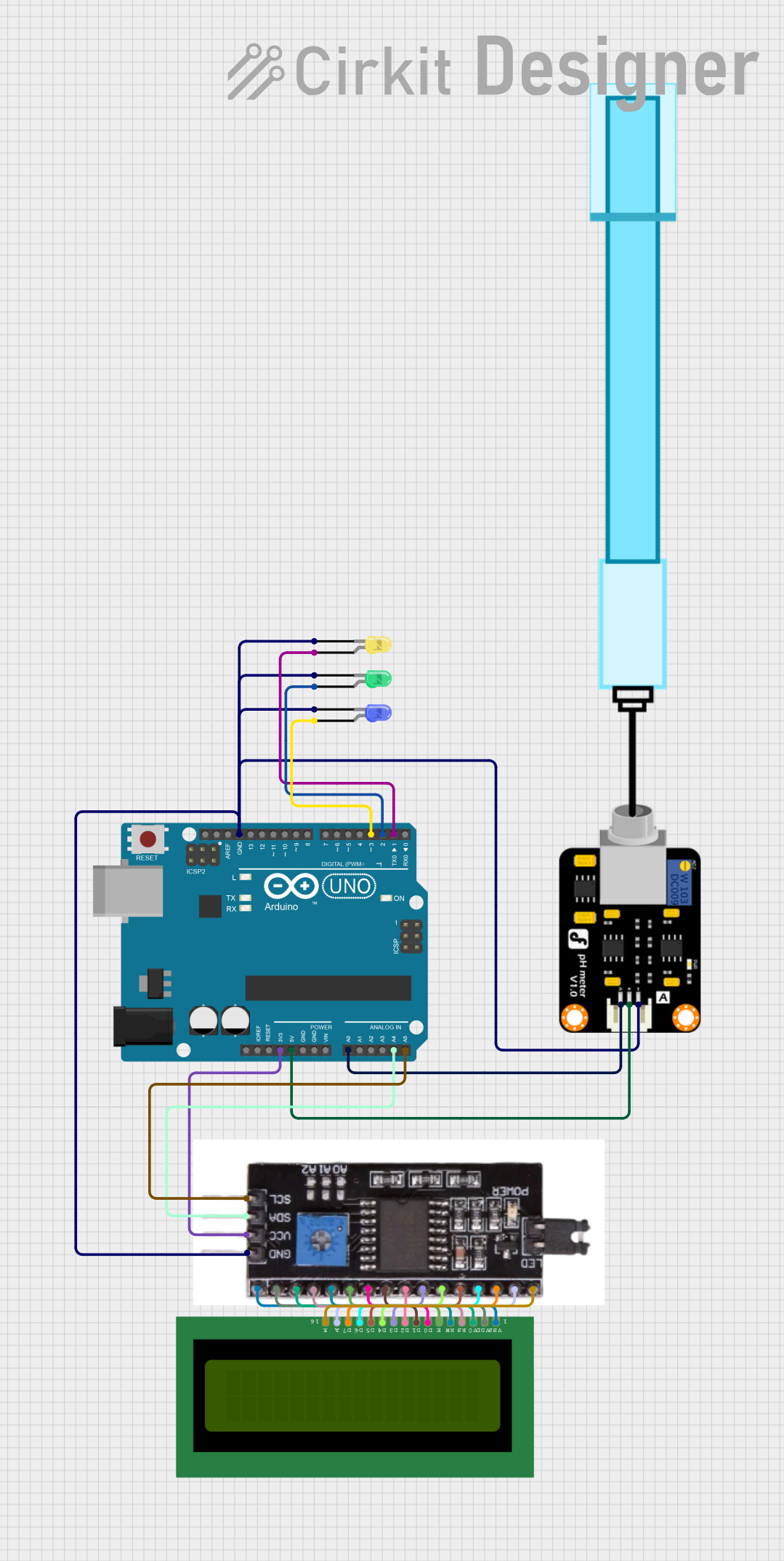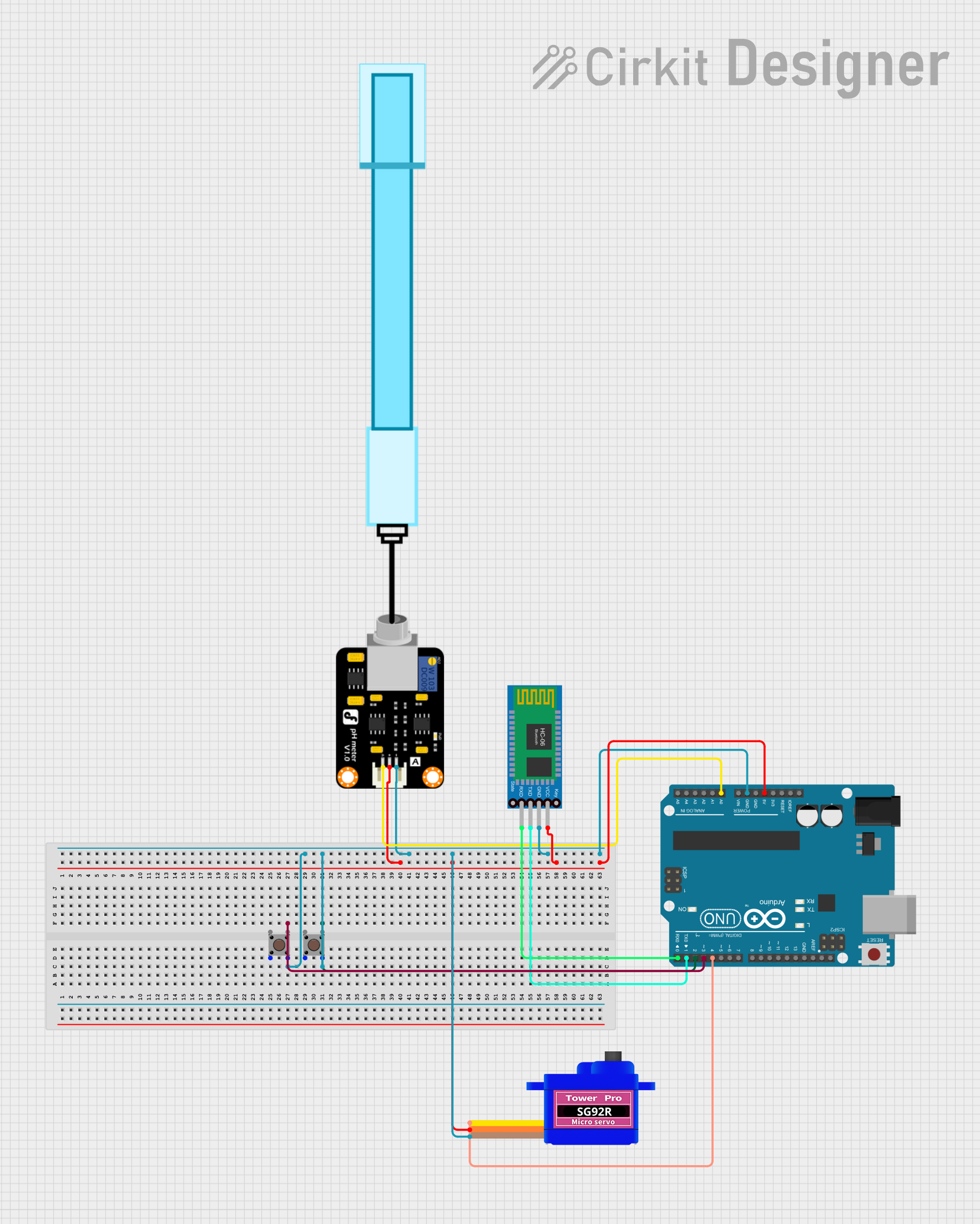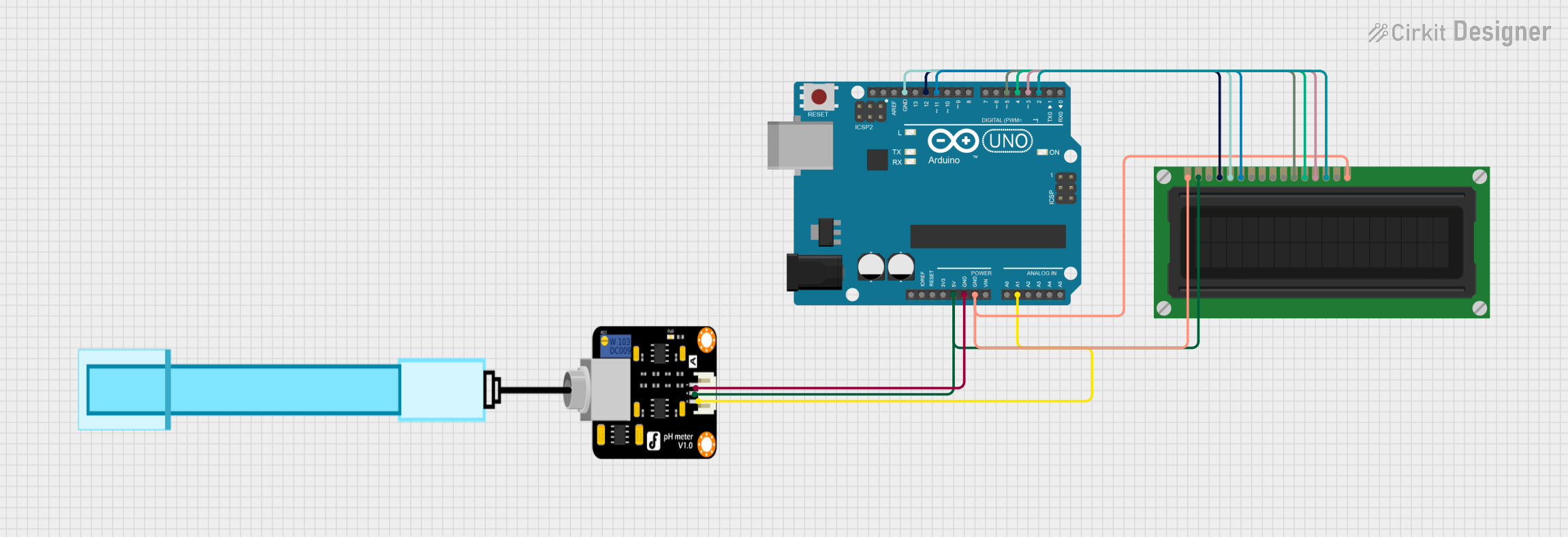
Cirkit Designer
Your all-in-one circuit design IDE
Home /
Component Documentation
How to Use pH Level Sensor: Examples, Pinouts, and Specs

 Design with pH Level Sensor in Cirkit Designer
Design with pH Level Sensor in Cirkit DesignerIntroduction
The pH Level Sensor is a device used to measure the acidity or alkalinity of a solution, typically providing an output in pH units. This sensor is essential in various applications, including water quality monitoring, aquariums, hydroponics, and laboratory experiments. By converting the hydrogen ion concentration in a solution into an electrical signal, the pH Level Sensor allows for precise and real-time pH measurements.
Explore Projects Built with pH Level Sensor
Arduino UNO Based pH Meter with LCD Display and Indicator LEDs

This circuit is designed to measure the pH level of a solution and display the value on an LCD screen. It uses an Arduino UNO microcontroller to read the pH sensor's signal and control three LEDs (yellow, green, blue) to indicate the pH level: yellow for acidic (pH < 5), green for neutral (pH 5-8), and blue for basic (pH > 8). The LCD displays a welcome message on startup and then continuously updates with the current pH value.
 Open Project in Cirkit Designer
Open Project in Cirkit DesignerArduino UNO Based pH Monitoring System with Bluetooth Connectivity

This circuit is designed to measure pH levels using a pH meter connected to an Arduino UNO, which processes the sensor data and controls a servomotor based on the readings. The Arduino also interfaces with a Bluetooth HC-06 module for wireless communication, potentially to send pH data to a remote device. Two pushbuttons are included in the circuit, likely for user input, and the servomotor's operation is presumably linked to the pH readings, although the specific functionality is not detailed in the provided code.
 Open Project in Cirkit Designer
Open Project in Cirkit DesignerArduino UNO Based pH Meter with LCD Display

This circuit is designed to measure the pH level of a solution using a pH meter connected to an Arduino UNO microcontroller. The Arduino reads the pH value from the sensor, processes the signal, and displays the result on an LCD I2C display. The code for the Arduino includes initialization of the display, reading and filtering the sensor signal, calculating the pH value, and updating the display with the current pH reading.
 Open Project in Cirkit Designer
Open Project in Cirkit DesignerArduino UNO pH Meter with LCD Display

This circuit is designed to measure pH levels using a pH meter and display the readings on an LCD screen. An Arduino UNO microcontroller reads the pH sensor data through its analog input pin A1 and controls the LCD display via its digital pins to show the pH value.
 Open Project in Cirkit Designer
Open Project in Cirkit DesignerExplore Projects Built with pH Level Sensor

Arduino UNO Based pH Meter with LCD Display and Indicator LEDs
This circuit is designed to measure the pH level of a solution and display the value on an LCD screen. It uses an Arduino UNO microcontroller to read the pH sensor's signal and control three LEDs (yellow, green, blue) to indicate the pH level: yellow for acidic (pH < 5), green for neutral (pH 5-8), and blue for basic (pH > 8). The LCD displays a welcome message on startup and then continuously updates with the current pH value.
 Open Project in Cirkit Designer
Open Project in Cirkit Designer
Arduino UNO Based pH Monitoring System with Bluetooth Connectivity
This circuit is designed to measure pH levels using a pH meter connected to an Arduino UNO, which processes the sensor data and controls a servomotor based on the readings. The Arduino also interfaces with a Bluetooth HC-06 module for wireless communication, potentially to send pH data to a remote device. Two pushbuttons are included in the circuit, likely for user input, and the servomotor's operation is presumably linked to the pH readings, although the specific functionality is not detailed in the provided code.
 Open Project in Cirkit Designer
Open Project in Cirkit Designer
Arduino UNO Based pH Meter with LCD Display
This circuit is designed to measure the pH level of a solution using a pH meter connected to an Arduino UNO microcontroller. The Arduino reads the pH value from the sensor, processes the signal, and displays the result on an LCD I2C display. The code for the Arduino includes initialization of the display, reading and filtering the sensor signal, calculating the pH value, and updating the display with the current pH reading.
 Open Project in Cirkit Designer
Open Project in Cirkit Designer
Arduino UNO pH Meter with LCD Display
This circuit is designed to measure pH levels using a pH meter and display the readings on an LCD screen. An Arduino UNO microcontroller reads the pH sensor data through its analog input pin A1 and controls the LCD display via its digital pins to show the pH value.
 Open Project in Cirkit Designer
Open Project in Cirkit DesignerTechnical Specifications
Key Technical Details
| Parameter | Value |
|---|---|
| Operating Voltage | 5V DC |
| Measuring Range | 0 - 14 pH |
| Accuracy | ±0.1 pH (at 25°C) |
| Response Time | ≤ 1 minute |
| Temperature Range | 0 - 60°C |
| Output Type | Analog |
| Calibration | 2-point calibration (pH 4.0, pH 7.0) |
Pin Configuration and Descriptions
| Pin Number | Pin Name | Description |
|---|---|---|
| 1 | VCC | Power supply (5V DC) |
| 2 | GND | Ground |
| 3 | AO | Analog output (pH value as voltage) |
Usage Instructions
How to Use the Component in a Circuit
- Power Supply: Connect the VCC pin to a 5V DC power supply and the GND pin to the ground.
- Analog Output: Connect the AO pin to an analog input pin on a microcontroller (e.g., Arduino UNO).
- Calibration: Calibrate the sensor using standard buffer solutions (pH 4.0 and pH 7.0) to ensure accurate readings.
Important Considerations and Best Practices
- Calibration: Regularly calibrate the sensor to maintain accuracy. Use fresh buffer solutions for calibration.
- Temperature Compensation: Be aware that pH readings can be affected by temperature. Use a temperature compensation method if precise measurements are required.
- Cleaning: Clean the sensor probe with distilled water after each use to prevent contamination and ensure longevity.
- Storage: Store the sensor in a pH 4.0 buffer solution when not in use to keep the probe hydrated.
Example Code for Arduino UNO
// pH Level Sensor Example Code for Arduino UNO
const int sensorPin = A0; // Analog input pin connected to AO pin of pH sensor
float voltage;
float pHValue;
void setup() {
Serial.begin(9600); // Initialize serial communication at 9600 baud rate
}
void loop() {
int sensorValue = analogRead(sensorPin); // Read the analog value from the sensor
voltage = sensorValue * (5.0 / 1023.0); // Convert the analog value to voltage
pHValue = 3.5 * voltage; // Convert the voltage to pH value (calibration may be needed)
Serial.print("Voltage: ");
Serial.print(voltage);
Serial.print(" V, pH Value: ");
Serial.println(pHValue);
delay(1000); // Wait for 1 second before taking another reading
}
Troubleshooting and FAQs
Common Issues Users Might Face
- Inaccurate Readings: The sensor may provide inaccurate readings if not properly calibrated or if the probe is dirty.
- Slow Response Time: A slow response time can occur if the sensor probe is not adequately hydrated or if there is a buildup of contaminants.
- Fluctuating Readings: Fluctuating readings can be caused by electrical noise or unstable power supply.
Solutions and Tips for Troubleshooting
- Calibration: Ensure the sensor is calibrated using fresh buffer solutions. Perform a 2-point calibration for best results.
- Cleaning: Rinse the sensor probe with distilled water and gently clean it with a soft brush if necessary.
- Hydration: Store the sensor in a pH 4.0 buffer solution when not in use to keep the probe hydrated.
- Stable Power Supply: Use a stable and regulated power supply to minimize electrical noise and fluctuations.
By following these guidelines and best practices, users can achieve accurate and reliable pH measurements with the pH Level Sensor.